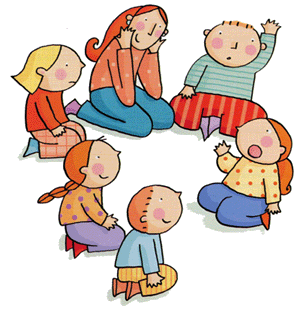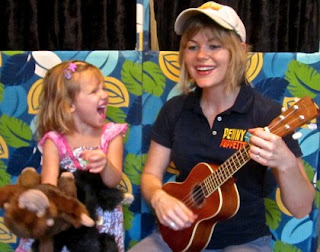Writing songs is an art form, and like any other art form there are principles for writing songs that make them stand out and shine in our memory. The reason we were so drawn to our favorite children's songs is because the songwriters who wrote them understood the way children learn and the way the human brain retains information. If you follow these tried and true building blocks of children's songwriting, then you too will be able to create songs that your children or students will be singing out loud for a very, very long time!
1. Make it rhyme!
Choose words that rhyme to make the song catchy and easy to remember. When words rhyme in a song, children will learn to expect what words come next and be ready to say them out loud. Rhyming also gives children a sense of confidence since they will be able to learn the song so much quicker. You can use this as an opportunity to introduce new vocabulary (moose, loose and caboose to a child who already knows goose) or to talk about what it means when words rhyme (time rhymes with lime, but does time rhyme with orange?)
Remember what happened to the Itsy, Bitsy Spider on it's perilous quest up a water spout? Sure you do, because it involved actions. The song about an audacious spider is so popular with children because we get to see what happens to it as the teacher performs the sequence of events and then we have fun learning to do it ourselves (and then teaching it to our friends and siblings). If you use actions in a song it will give children an opportunity to act them out, and this makes it much more likely for it to stick with them for a very long time.
3. Choose a familiar melody.
You can choose a song that children already know and use this as a starting point for writing your song. A familiar, tried and true melody guarantees that children will already know it and you can modify it by changing the lyrics. If you prefer to go the composer route, stick to simple melodies and use as little as two chords in your song. Not only does this make it easier to remember for kids, it makes it easier to play for adults.
The next step is designing the structure of your song. A common song structure is: verse / chorus / verse / chorus / bridge / chorus. This form provides enough repetition to feel familiar and enough variety to keep the listener interested. Think of Old MacDonald Had A Farm, using repetition allows the children to predict what happens next without knowing exactly what animal comes next in the song. This allows the children to remember the song more easily and sing it all by themselves the next time they do so.
The verses in a song all have the same melody but different lyrics. The verse lyrics tell about the situation, emotions or people in the song.
The chorus in a song always has the same melody and lyrics and may be repeated in the song three or more times. The chorus lyrics sum up the heart of the song and the title of the song is almost always contained in this section.
The bridge of the song contains lyrics separate from the the verse or the chorus. It provides a break from the repetition and is used to reveal an insight or important moment in the story.
A laughing kid is a happy kid and science has shown that the brain tends to recall memories associated with strong positive or negative emotions more strongly. Comedy is a great way to attract children's attention and keep it focused on you as you perform the song. Therefore, it acts as an invaluable tool for teaching. Don't be afraid to be outrageous, zany or loony in your song lyrics. If it gives kids the giggles, then you have done your job well.
6. Use animals.
Can you name one classic children's song or nursery rhyme featuring animal characters that isn't popular? You'll likely be stumped trying to figure out the answer to this question. Its true, kids enjoy watching TV shows, reading books, playing games and of course singing songs that include animal protagonists. Think of Five Little Monkeys Jumping On The Bed! Pop Goes The Weasel, and This Little Piggy. In fact, Teddy Bears are a favorite toy of children everywhere because they're designed to be soft, cute and cuddly and appeal to children's sense of caring for animal characters. You can write a song with your child featuring their personal teddy bear as the main character and your child will cherish it and remember it whenever they play with their teddy.
Parents will love this category. Children's songs can be used not only to teach academic subjects but to teach practical life skills too. You can teach kids stuff by singing it: brush your teeth, tie your shoes, make your bed. They'll like it and be more likely to do it if you sing it instead of just telling them! You can write a song to teach your child to put away his or her toys, to always say please and thank you, or to learn to share with friends: the possibilities are endless and the children are guaranteed to enjoy it just as much as parents.
Kids can learn to brush their teeth from a song!
8. Remember To Have Fun!
Remember that you as the teacher or parent create the experience for the children to enjoy. So let loose and have fun, if the song needs to be acted out then don't be embarrassed and play your part well! Don't be too shy to "cluck" like a chicken, "neigh" like a horse, or "croak" like a frog if the song calls for it- It's all part of the activity :-). Your children or students will love you for it and you will have accomplished your objective of bringing learning, music and play into children's lives.
For more great song ideas for children, visit our Sing Along With Kids Pinterest board from Starburst Piano & Voice Studios.
Leave a comment below and let us know: What's your favorite children's song from your childhood? What children's songs do you teach to your children or students in the classroom? How do you make song time fun?
















